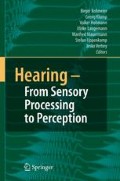An extensive literature shows that when the same sound is presented to both ears rather than to just one, a phenomenon called binaural summation occurs (Reynolds and Stevens 1960), in which the overall loudness of a stimulus presented to both ears is greater. A much smaller literature on the effect of interaural correlation on binaural loudness indicates that it has no additional effect (Dubrovskii and Chernyak 1969; Dubrovskii et al. 1972). However, Culling et al. (2001) found that listeners judged a band of noise spectrally flanked by correlated noise as progressively louder as its interaural correlation decreased towards zero. Culling et al. attributed the effect to the mechanism of binaural unmasking (e.g. Durlach 1972; Culling and Summerfield 1995).
Access this chapter
Tax calculation will be finalised at checkout
Purchases are for personal use only
Preview
Unable to display preview. Download preview PDF.
References
Culling JF, Summerfield Q (1995) Perceptual segregation of concurrent speech sounds: absence of across-frequency grouping by common interaural delay. J Acoust Soc Am 98:785–797.
Culling JF, Summerfield Q (1998) Measurements of the binaural temporal window using a detection task. J Acoust Soc Am 103:3540–3553.
Culling JF, Colburn HS, Spurchise M (2001) Interaural correlation sensitivity. J Acoust Soc Am 110:1020–1029.
Culling JF, Hodder KI, Colburn HS (2003) Interaural correlation discrimination with spectrally-remote flanking bands: constraints for models of binaural unmasking. Acta Acust united with Acustica 89:1049–1058.
Dubrovskii NA, Chernyak RI (1969) Binaural summation under varying degrees of noise correlation. Sov Phys Acoust 14:326–332.
Dubrovskii NA, Chernyak RI, Shapiro VM (1972) Binaural summation of differently correlated noises. Sov Phys Acoust 17:468–473.
Durlach NI (1972) Binaural signal detection: equalization and cancellation theory. In: Tobias JV (ed) Foundations of modern auditory theory, vol 2. Academic Press, New York, pp 369–462.
Durlach NI, Gabriel KJ, Colburn HS, Trahiotis C (1986) Interaural correlation discrimination: II. Relation to binaural unmasking. J Acoust Soc Am 78:1458–1557.
Grantham DW, Wightman FL (1978) Detectability of varying interaural temporal differences. J Acoust Soc Am 63:511–523.
Levitt H (1971) Transformed up-down methods in psychoacoustics. J Acoust Soc Am 49:467–477.
Moore BCJ, Glasberg BR, Vickers DA (1999) Further evaluation of a model of loudness perception applied to cochlear hearing loss. J Acoust Soc Am 106:898–907.
Osman E (1971) A correlation model of binaural masking level differences. J Acoust Soc Am 50:1494–1495.
Reynolds GS, Stevens SS (1960) Binaural summation of loudness. J Acoust Soc Am 32:192–205.
Robinson DW (1971) A review of audiometry. Phys Med Biol 16:1–24.
Scharf B, Fishken D (1970) Binaural summation of loudness reconsidered. J Exp Psych 86:374–379.
Zwicker E, Scharf B (1965) A model of loudness summation. Psych Rev 72:3–26.
Zwicker E, Zwicker UT (1991) Dependence of binaural loudness summation on interaural level differences, spectral distribution, and temporal resolution. J Acoust Soc Am 89:758–764.
References
Brand A, Behrend O, Marquardt T, McAlpine D, Grothe B (2002) Precise inhibition is essential for microsecond interaural time difference coding. Nature 417:543–547
Scharf B (1970) Critical bands. In: Tobias JV (ed) Foundations of modern auditory theory, vol 1. Academic Press, pp 159–202.
Shamma SA, Shen N, Gopalaswamy P (1989) Stereausis: binaural processing without neural delays. J Acoust Soc Am 86:989–1006.
Author information
Authors and Affiliations
Editor information
Editors and Affiliations
Rights and permissions
Copyright information
© 2007 Springer-Verlag Berlin Heidelberg
About this paper
Cite this paper
Culling, J.F., Edmonds, B.A. (2007). Interaural Correlation and Loudness. In: Kollmeier, B., et al. Hearing – From Sensory Processing to Perception. Springer, Berlin, Heidelberg. https://doi.org/10.1007/978-3-540-73009-5_39
Download citation
DOI: https://doi.org/10.1007/978-3-540-73009-5_39
Publisher Name: Springer, Berlin, Heidelberg
Print ISBN: 978-3-540-73008-8
Online ISBN: 978-3-540-73009-5
eBook Packages: Biomedical and Life SciencesBiomedical and Life Sciences (R0)

